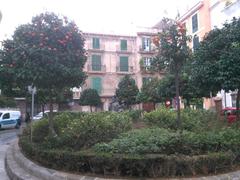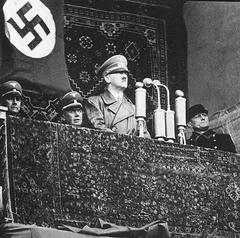
Comprehensive Guide to Visiting Klaipėda City Municipality, Lithuania
Date: 13/08/2024
Captivating Introduction
Welcome to Klaipėda, a city where history whispers through the cobblestone streets and the Baltic Sea sings a timeless melody. Imagine a place where medieval knights once roamed, where centuries-old architectural marvels stand tall, and where vibrant festivals celebrate a rich cultural tapestry. Klaipėda, originally known as Memel, is a city that has seen it all—conquests, treaties, and revolts, each leaving an indelible mark on its character. From its origins in 1252, when the Teutonic Knights established Memelburg, to its transformation into Lithuania’s bustling maritime hub, Klaipėda offers a journey through time unlike any other (Wikipedia).
But Klaipėda is more than just its history. It’s a city where German and Lithuanian influences blend seamlessly, creating a unique cultural mosaic. Picture yourself wandering through the Old Town’s cobbled streets, marveling at its German-style architecture, or standing atop the Parnidis Dune on the Curonian Spit, a UNESCO World Heritage site, taking in the breathtaking views of the Baltic Sea (Nordic Experience). Whether you’re here for the bustling Sea Festival, exploring the Lithuanian Sea Museum, or simply savoring the local seafood delicacies, Klaipėda promises an unforgettable adventure.
So grab your walking shoes, your sense of adventure, and let Audiala guide you through the hidden stories and secrets of Klaipėda. Ready to dive in? Let’s embark on this journey together!
Table of Contents
- Historical Overview of Klaipėda City Municipality
- Why Klaipėda is a Gem
- Visitor Tips for Klaipėda City Municipality, Lithuania
- Call to Action
Historical Overview of Klaipėda City Municipality
Early Beginnings and Medieval Era
Did you know Klaipėda, originally called Memelburg, has roots stretching back to July 29, 1252? Picture a grand wooden castle rising between the Nemunas and Dangė rivers, built under an agreement between the Grand Master of the Livonian Order and the Bishop of Courland. This castle, though reconstructed multiple times, saw its final days in the 19th century when it was demolished due to its lost strategic importance. Imagine the echoes of medieval life in every corner! (LRT)
The Memel Territory and the Treaty of Versailles
Fast forward to 1920, and the Treaty of Versailles defines the Klaipėda Region, or Memel Territory. Administered by the Entente’s Council of Ambassadors, this region’s fate was to be decided by a future plebiscite. It’s like a geopolitical chess game! (Wikipedia)
Interwar Period and Lithuanian Annexation
Post-World War I, the Klaipėda Region was a pivotal area bordered by the Treaty of Melno border, the Neman River, and the Baltic Sea. In a bold move in 1923, Lithuania seized control, integrating Klaipėda into its state. This was a game-changer, providing Lithuania with a prime, ice-free Baltic port, transforming it into a hub for agricultural exports. Imagine the bustling port scenes! (Wikipedia)
World War II and Soviet Era
March 1939 saw Klaipėda ceded to Nazi Germany under duress, only to be incorporated into the Lithuanian SSR by the Soviet Union in 1945. This status quo lasted until Lithuania’s 1990 independence, reclaiming Klaipėda for the Republic of Lithuania. Each era left an indelible mark on the city’s soul. (Wikipedia)
Modern Era and Cultural Significance
Today, Klaipėda celebrates its rich history and culture, marking milestones like its 772nd anniversary with grand festivities. Picture flags flying at Klaipėda Castle, educational activities in Karlskrona Square, and the air alive with concerts, medieval dances, ancient crafts, and noble fights. It’s a celebration you wouldn’t want to miss! (LRT)
Autonomy and Governance
The Klaipėda Convention of 1924 granted the region its own parliament, dual official languages, and the right to manage its taxes, customs, cultural, and religious affairs. Talk about autonomy! This was further solidified by a 1928 Lithuanian-German Arbitration and Settlement Agreement, showcasing Klaipėda’s unique governance history. (Wikipedia)
Cultural and Historical Attractions
From the Lithuanian Sea Museum in the historic Nerija Fort to the Blacksmithing Museum celebrating folk artist Dionyzas Varkalis, Klaipėda’s attractions offer a rich tapestry of cultural experiences. Imagine exploring these hidden gems, each with a story to tell! (Nordic Experience)
The Curonian Spit
A UNESCO World Heritage site, the Curonian Spit is a stunning 98-kilometer sand dune that separates the Curonian Lagoon from the Baltic Sea. Picture yourself amidst the Grey Dunes, watching migrating birds, and soaking in the serene beauty of this unique landscape. (Nordic Experience)
Architectural Heritage
Klaipėda’s architectural charm is a blend of German and Lithuanian influences. Stroll through the Old Town with its cobblestone streets, visit Theatre Square, and discover whimsical sculptures like the ‘Magical Mouse’ and ‘The Cat with the Face of a Gentleman.’ Each landmark whispers tales of the past. (Unusual Traveler)
Why Klaipėda is a Gem
Strategic Port City
Klaipėda is Lithuania’s maritime heartbeat, its only major seaport, bustling with life and trade year-round—no ice can freeze this port’s spirit (ctdots.eu). Its strategic location has historically made it a focal point for both trade and military endeavors, contributing to its rich cultural and architectural tapestry.
Cultural Melting Pot
Imagine a city where German and Lithuanian heritages dance together in harmony. That’s Klaipėda. From its architecture to its festivals, this city is a vibrant canvas of influences. The annual Sea Festival is a must-experience, drawing hundreds of thousands for a maritime celebration of concerts, markets, and more (True Lithuania).
Economic and Creative Hub
Klaipėda isn’t just about history; it’s a thriving hub for creative industries. As Lithuania’s Capital of Culture and a contender for the European Capital of Culture in 2022, it’s a playground for creativity (OECD). The Culture Factory (KUFA) is the city’s creative cauldron, brewing up cultural and creative enterprises.
Visitor Tips for Klaipėda City Municipality, Lithuania
Best Time to Visit
Klaipėda is a year-round destination, but your ideal visit depends on your interests. Summer (June to August) is perfect for beach activities and festivals. Don’t miss the Sea Festival, a vibrant event with music, food, and fireworks (Maptrotting). For a quieter, more intimate experience, visit in winter, particularly February, when Klaipėda hosts unique events like Shrove Tuesday, marking the end of winter (Top Travel Sights).
Accommodation
From budget to luxury, Klaipėda caters to all. For a mid-range option, Preliudija in the Old Town offers cozy charm (Top Travel Sights). If you’re after luxury, the Old Mill Hotel by the harbour is your spot, though a bit far from the bus station. Budget explorers can opt for Bridge Apartments, which come with kitchen facilities (Top Travel Sights).
Getting Around
Klaipėda’s compact size makes it a walker’s paradise. Stroll through the Old Town’s cobbled streets and historic architecture. For adventures further afield, like the Curonian Spit, rent a car or a bike. The city’s public transport is reliable, with buses and ferries. The passenger ferry from the Old Port to Smiltyne beach is a must-try (Maptrotting).
Key Attractions
Old Town
The Old Town is Klaipėda’s heart, with its unique fachwerk architecture and cobbled streets. Start at Theatre Square, home to the Drama Theatre and the Ann from Tharau statue, dedicated to German poet Simon Dach (Maptrotting). Don’t miss the Art Yard, a hub of local arts and crafts.
Castle Museum
Dive into Klaipėda’s history at the Castle Museum, featuring a detailed model of the city’s fortifications and various artefacts. Learn about its founding in 1252 by the Teutonic Order (Maptrotting).
Curonian Spit
A UNESCO World Heritage Site, the Curonian Spit is a treasure. Hike up the Parnidis Dune for stunning views of the lagoon and the Baltic Sea. It’s perfect for hiking, cycling, and bird-watching (Top Travel Sights).
Festivals and Events
Klaipėda’s festivals are legendary. The Sea Festival, held since 1934, is a must-see with music, food, and fireworks. Don’t miss the Klaipėda Castle Jazz Festival in early June (Maptrotting). And the Music Beach Festival in August draws both local and international bands (Maptrotting).
Dining and Nightlife
Klaipėda’s food scene is buzzing. Seafood lovers, rejoice! Try local dishes like herring. For a unique dining experience, head to the restaurant in the tower for panoramic city and sea views (Archmap).
Practical Tips
Language
Lithuanian is the official language, but English is widely spoken in tourist areas. Learning a few Lithuanian phrases will earn you smiles from locals.
Currency
Lithuania uses the Euro (€). Credit and debit cards are widely accepted, but carry some cash for smaller establishments.
Safety
Klaipėda is generally safe. Just follow standard precautions: keep an eye on belongings and avoid poorly lit areas at night.
Health
Healthcare in Klaipėda is good. EU citizens can use their European Health Insurance Card (EHIC) for emergency treatment. Travel insurance is recommended for non-EU visitors.
Shopping
From modern malls to local markets, Klaipėda has it all. The Old Town is packed with boutiques and souvenir shops. For a unique memento, grab some Baltic amber.
Day Trips
Ventes Cape
About 40 km from Klaipėda, Ventes Cape is a bird-watcher’s dream. Visit the lighthouse for panoramic views of the peninsula (Maptrotting).
Seaside Regional Park
Established in 1992, this park is a haven for outdoor enthusiasts. Don’t miss the Dutchman’s Cap (Olando Kepurė), a 24.4-meter tall sandy cliff (Maptrotting).
Local Legends and Culture
Klaipėda is steeped in legends and cultural heritage. The Klaipėda Black Ghost statue near the harbour commemorates a hooded figure who warned the city of an impending famine (Top Travel Sights). During Shrove Tuesday, witness the burning of the Effigy of winter (Top Travel Sights).
Call to Action
As we reach the end of our journey through Klaipėda, it’s clear that this city is a treasure trove of history, culture, and natural beauty. From its early days as Memelburg, through its turbulent years of conquests and annexations, to its modern-day status as a vibrant port city, Klaipėda has continually reinvented itself while preserving its rich heritage (Wikipedia).
Today, Klaipėda stands as a testament to resilience and transformation. Its strategic importance as Lithuania’s only major seaport has made it a bustling hub of trade and creativity. The city’s unique blend of German and Lithuanian cultures is evident in everything from its architecture to its festivals, creating a dynamic and welcoming atmosphere for visitors (ctdots.eu).
Whether you’re exploring the ancient ruins of Klaipėda Castle, hiking the stunning sand dunes of the Curonian Spit, or immersing yourself in the local festivals and culinary delights, Klaipėda offers something for everyone. And with Audiala as your guide, you’ll uncover the hidden gems and stories that make this city truly special. So pack your bags, download Audiala, and get ready to discover the magic of Klaipėda. Your adventure awaits!
References
- Klaipėda celebrates the city’s 772nd anniversary, 2024, LRT (source)
- Klaipėda Region, Wikipedia (source)
- Klaipėda, Wikipedia (source)
- Best Klaipėda See, Nordic Experience (source)
- Things to do Klaipėda Lithuania Baltic Sea, Intrepid Escape (source)
- Cities of Lithuania, True Lithuania (source)
- Culture and the Creative Economy in Lithuania and Municipalities of Klaipėda, Neringa and Palanga, 2023, OECD (source)
- Travel Guides Klaipėda, Travopo (source)
- Klaipėda Attractions, Lonely Planet (source)
- Things to do in Klaipėda, The World Was Here First (source)
- Klaipėda Travel Guide, Maptrotting (source)
- Top 8 Things to Do in Klaipėda, Top Travel Sights (source)
- The Complex of K and D Towers, Archmap (source)

